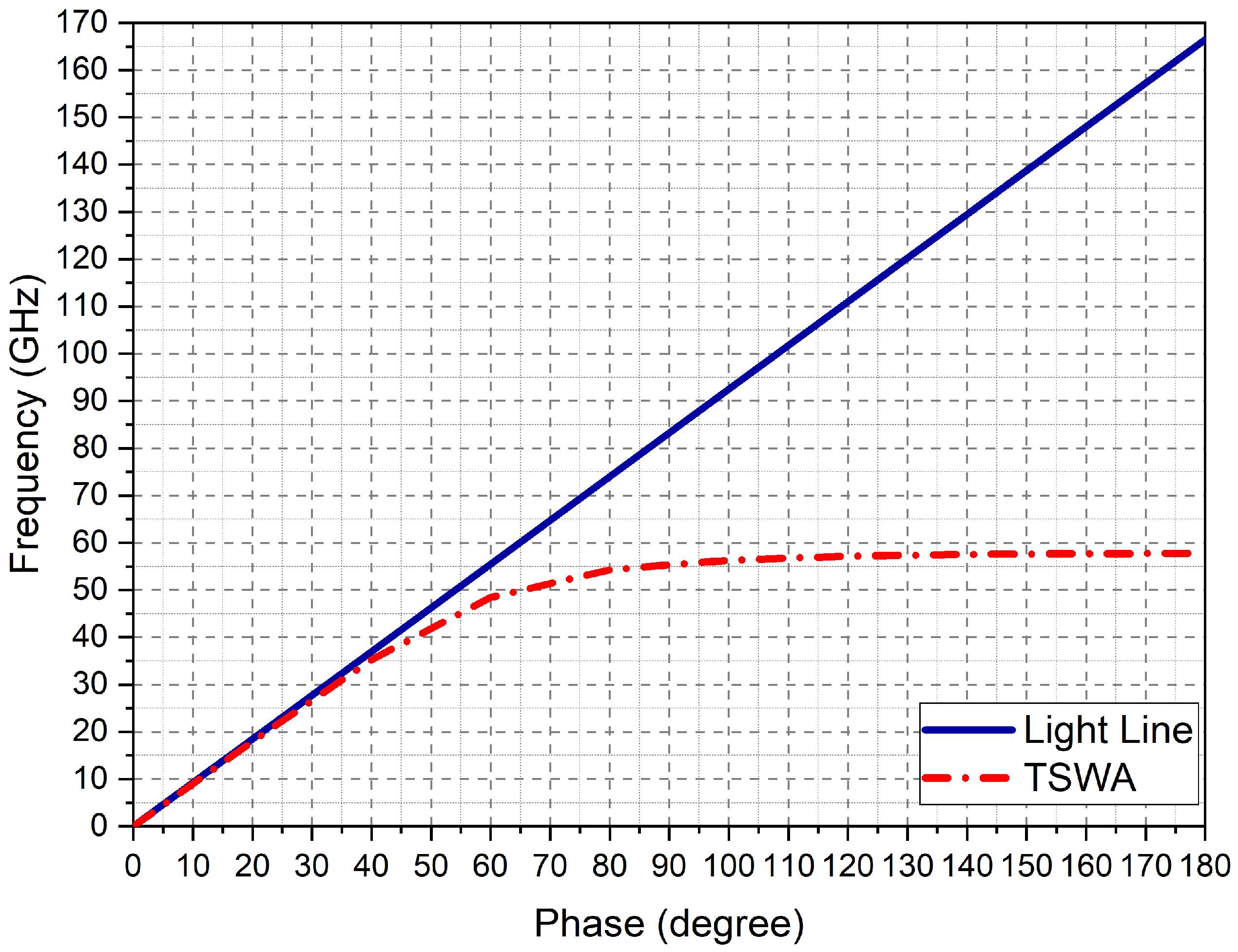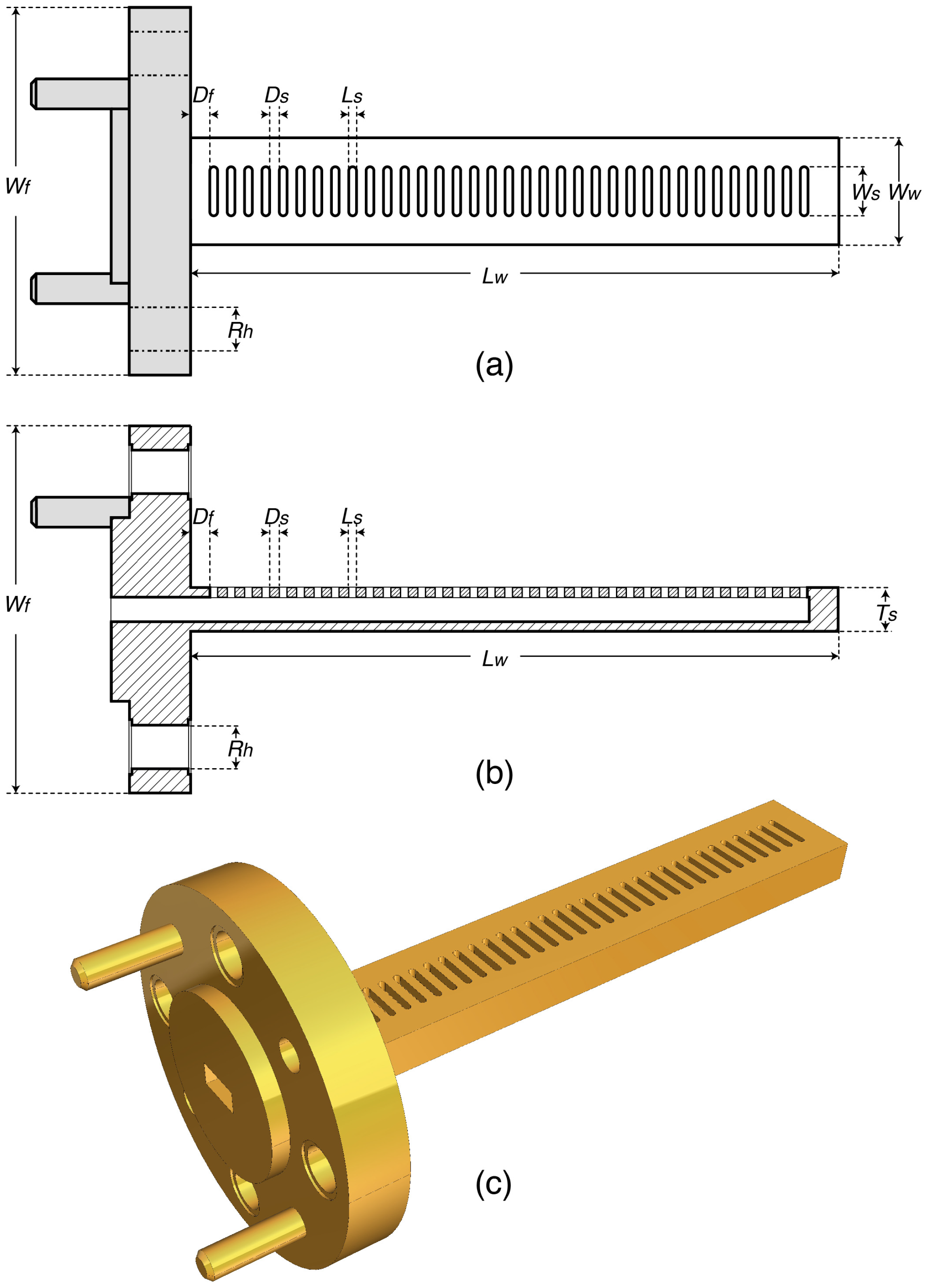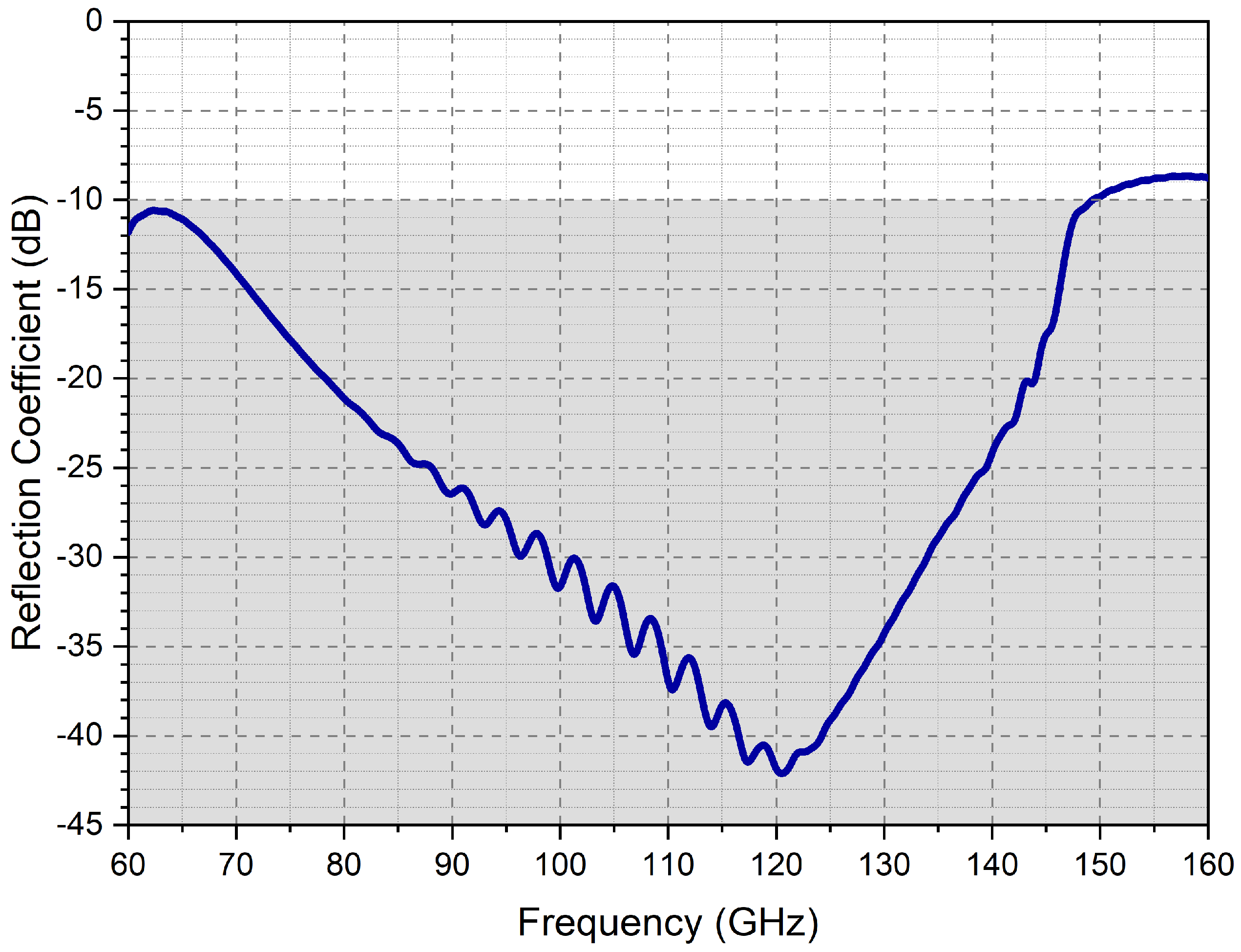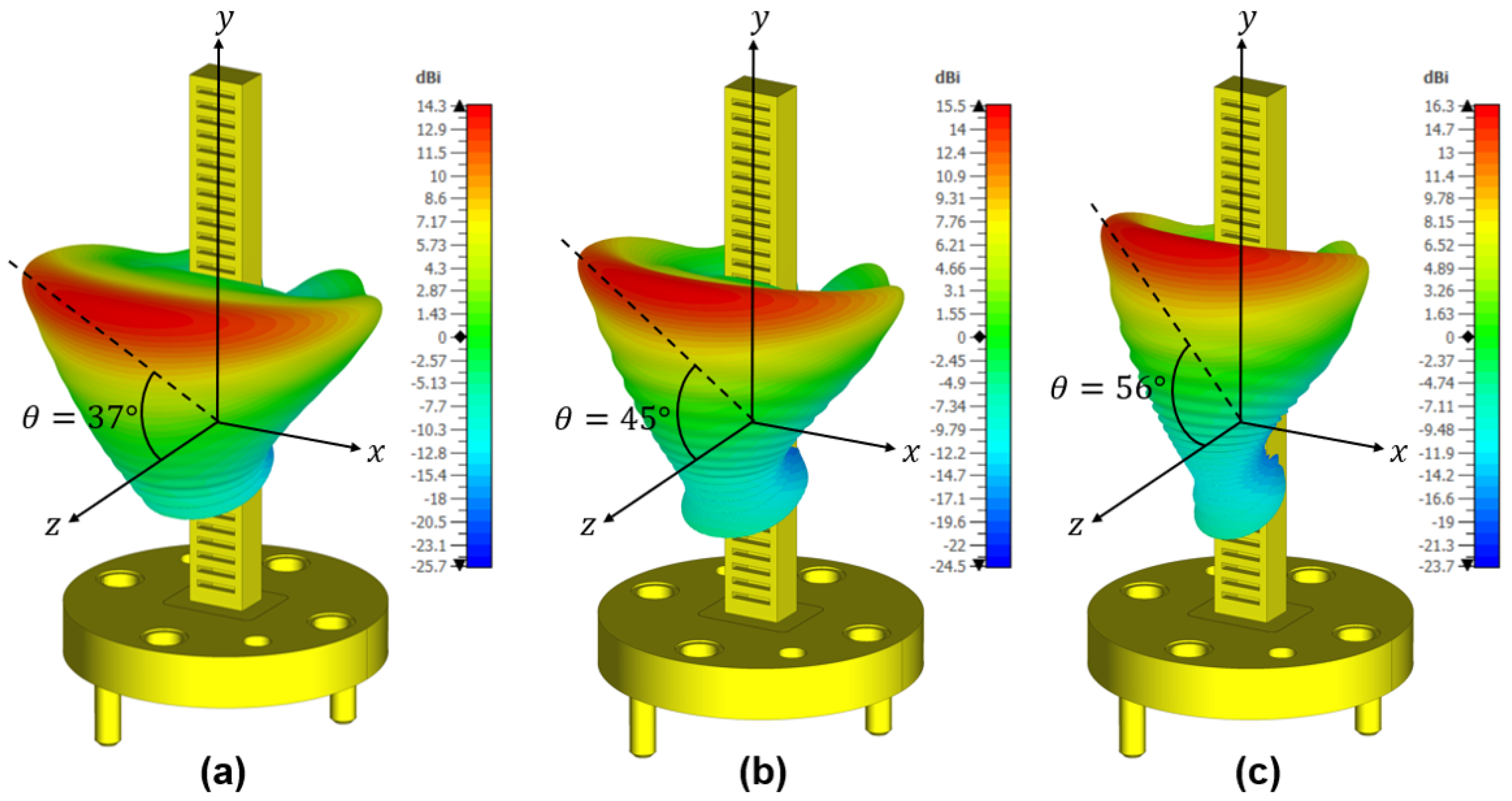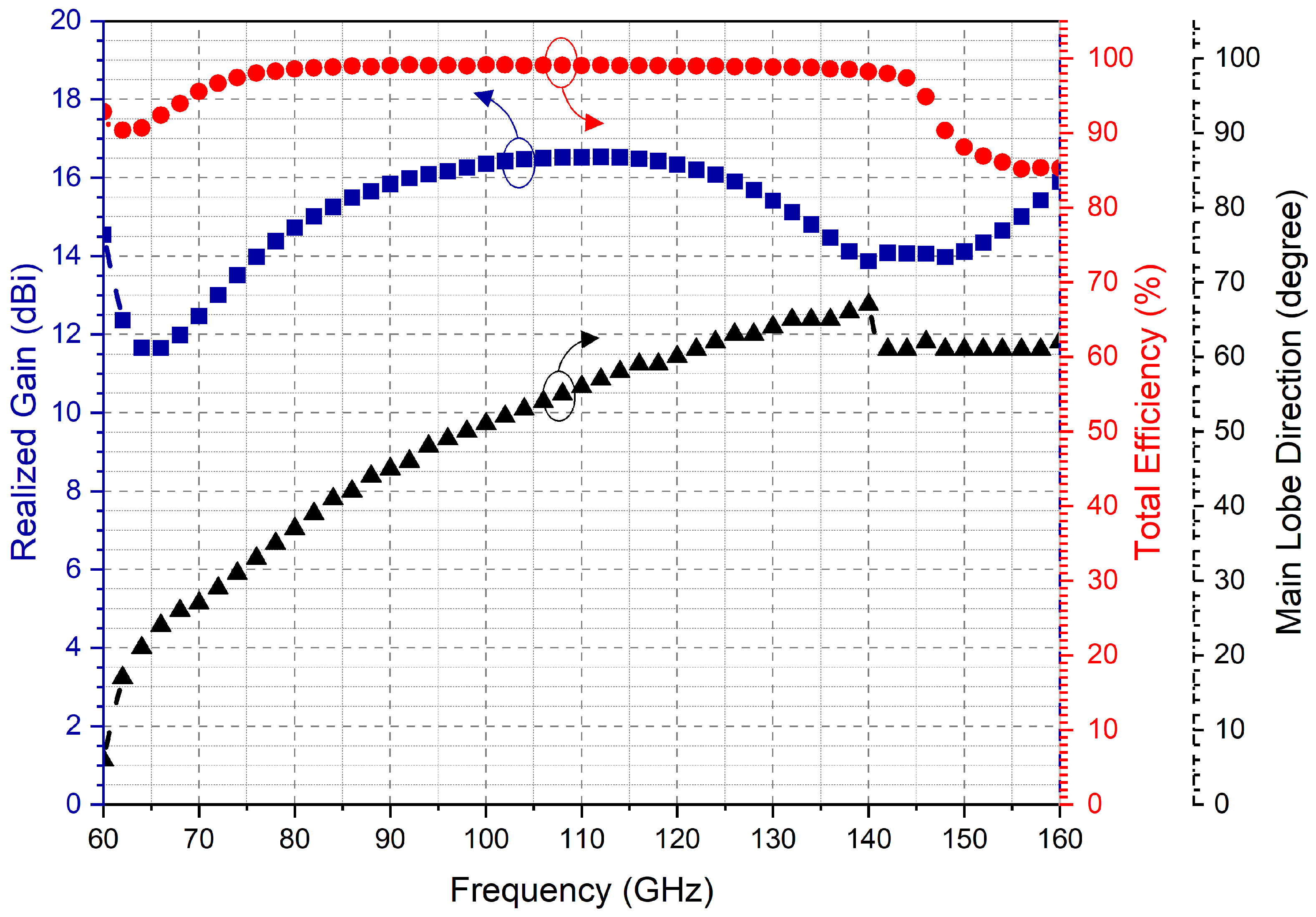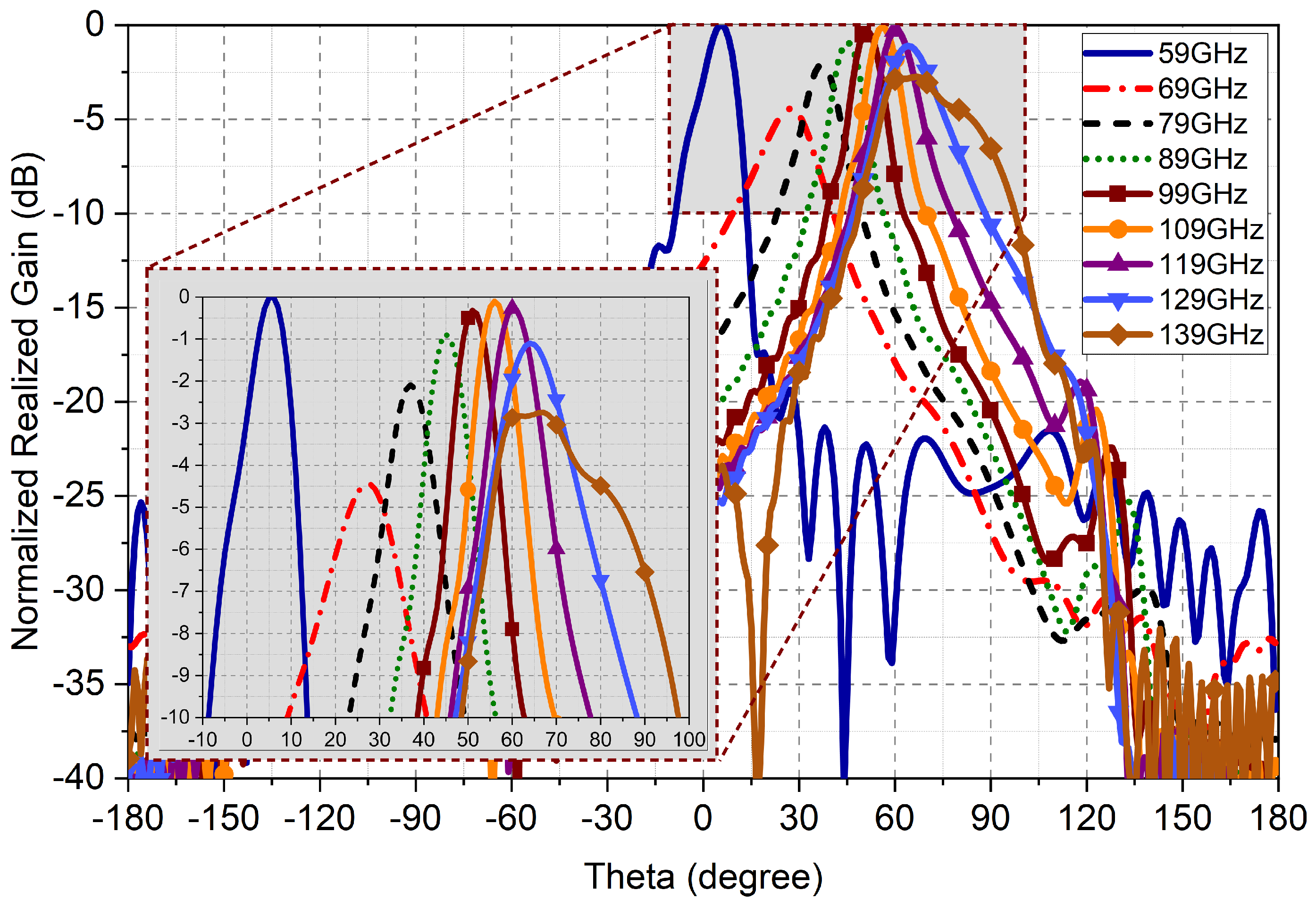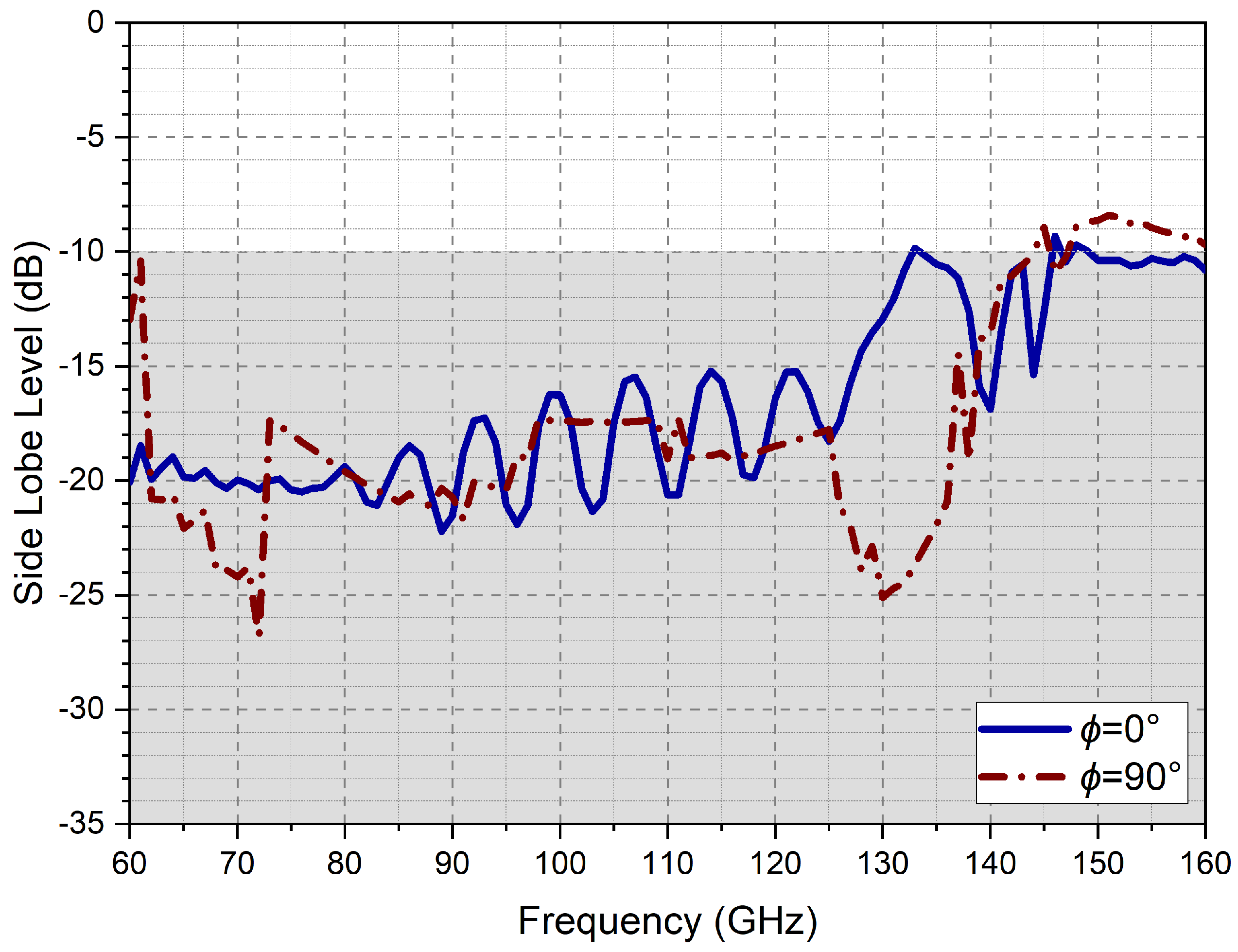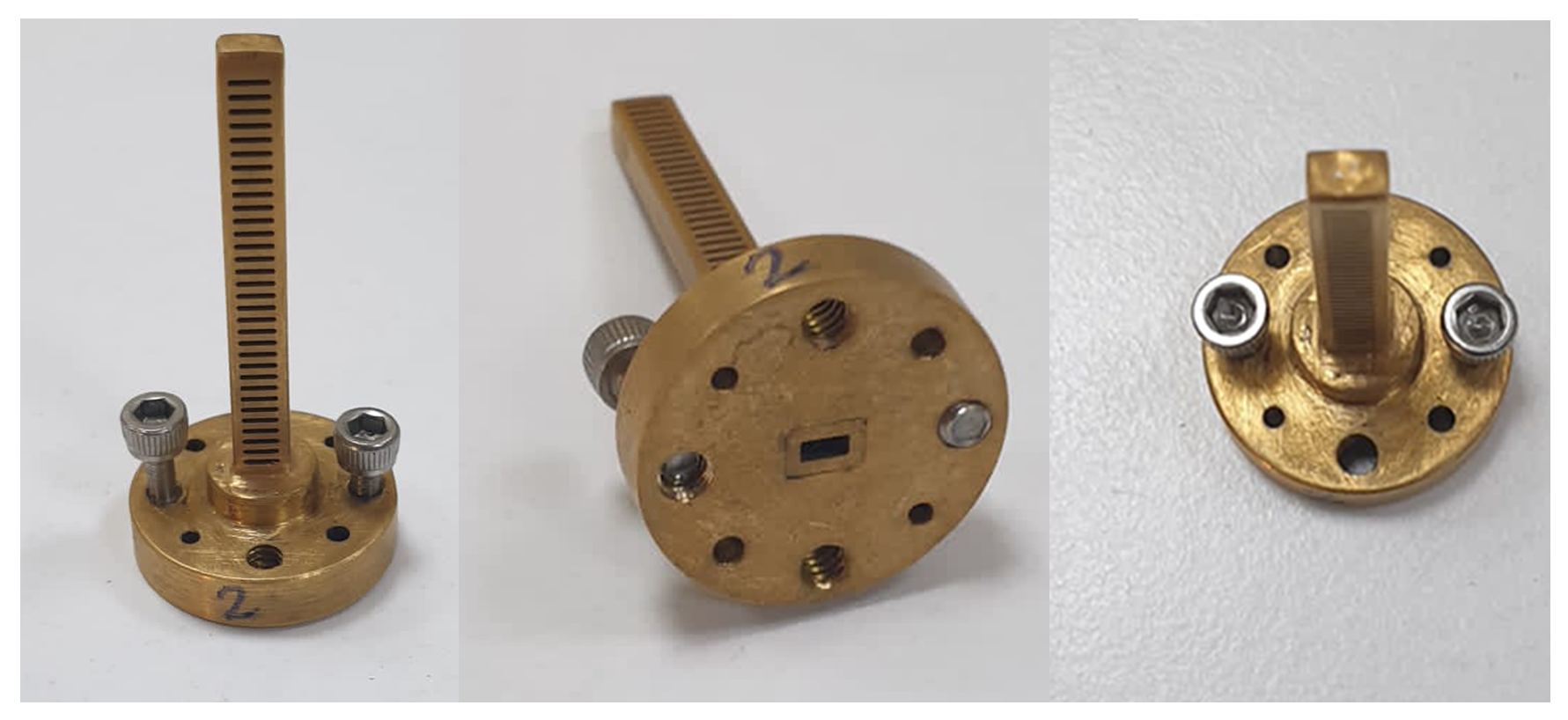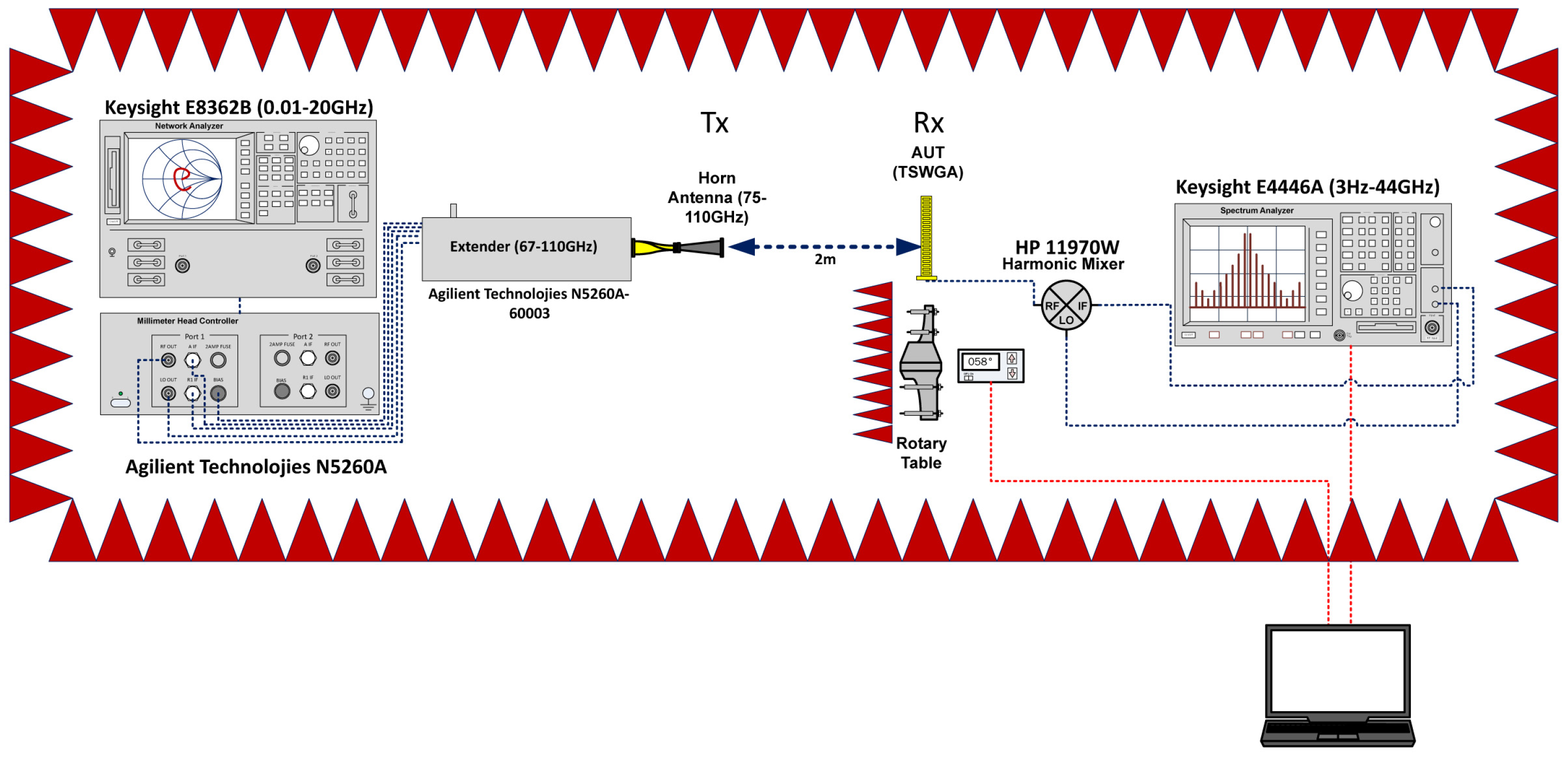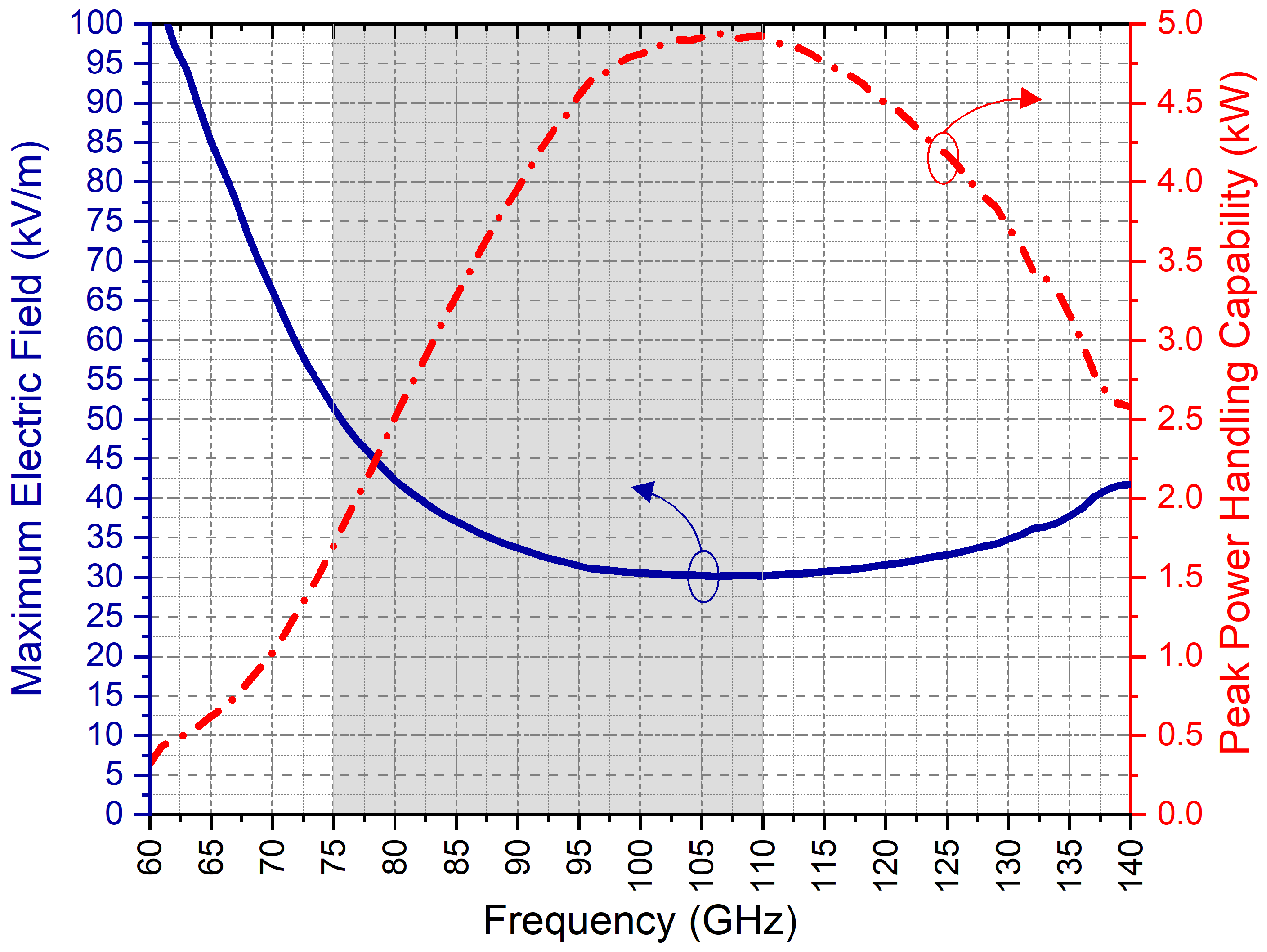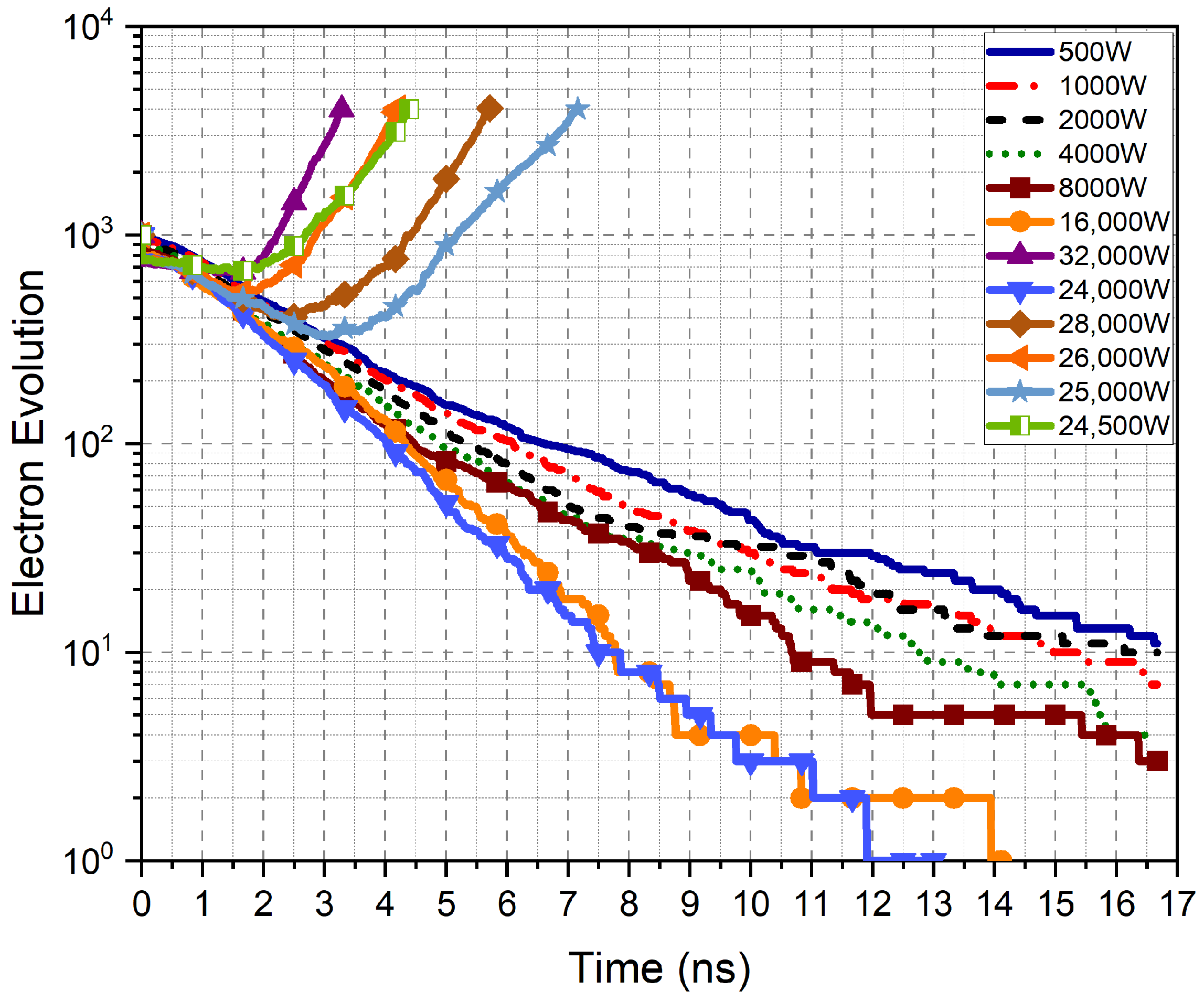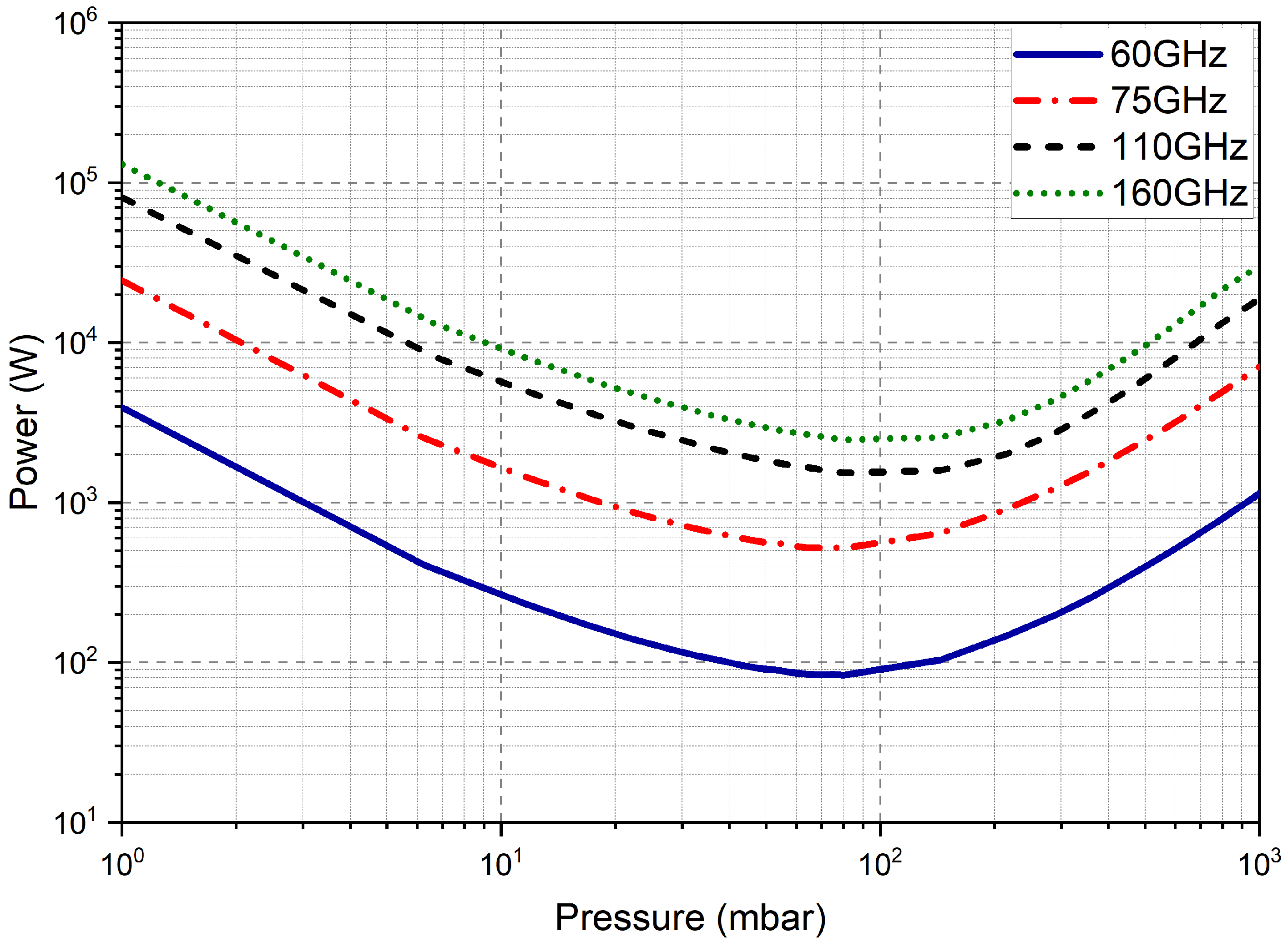1. Introduction
The advancement of technology and the changing demands have led to the expectation that 6G wireless communication technologies will facilitate worldwide communication without limitations of time or location. Hence, it is anticipated that the forthcoming 6G communication system would incorporate the integration of space networks and terrestrial networks, although 5G mobile and wireless systems mostly operate on the ground [
1,
2]. The utilization of THz technology is being evaluated as a means to fulfill the quality requirements anticipated for 6G, owing to its attributes encompassing security, high resolution, and broadband capabilities [
3]. In this context, understanding the fundamentals and limitations of terahertz (THz) technology becomes crucial. The origin of the term terahertz can be traced back to 1970, when it was used to describe the frequency range of a HeNe laser [
4]. Due to the advantages such as low photon energy, wide spectral range, and strong penetrability, terahertz technology has attracted attention since this date in medical imaging systems [
5], security detection applications, and defect detection of materials [
6]. However, THz waves within the THz gap region are significantly absorbed by water vapor and oxygen molecules in the atmosphere. Thus, the transmission distance is limited due to atmospheric attenuation in wireless communication applications. To address the critical challenge of the significant path loss caused by the vast distances between communication systems, transceivers with high output power, high sensitivity, and a low noise figure are required [
1].
Equally important is the design of high-gain THz antennas capable of handling high power, making this an essential focus in the field. Numerous studies in the literature are dedicated to advancing THz antenna technology. THz antennas made of metal [
7,
8,
9,
10], dielectric [
11,
12], and new materials such as carbon nanotube and graphene [
13,
14,
15,
16] have been proposed in the literature. Specifically, Fuscaldo et al. showed that using non-plasmonic leaky-wave modes in graphene-based Fabry–Perot cavity antennas can increase radiation efficiency to over 60%, compared to around 20% in plasmonic designs, making them suitable for efficient and tunable THz leaky-wave antennas and sensors [
14]. Hwu et al. investigated the potential applications of terahertz wireless communication to transfer data within spacecraft and between orbits [
17]. It has been reported that data rates exceeding 10 Gbps per 1 GHz of channel bandwidth can be achieved at THz frequencies. Han et al. proposed a terahertz space application system to be used in intersatellite links, which helps to reduce the path loss effect in the atmosphere [
18]. Additionally, the application difficulties of the terahertz antenna are highlighted. It is believed that a static communication system based on one or more fixed antennas will not meet the evolving needs of communication technology. Therefore, it is suggested that reconfigurable antennas operating at terahertz frequencies are advantageous. In [
19], Tamagnone et al. discovered that the hybrid graphene–metal bowtie antenna demonstrates the capability to achieve dynamic frequency reconstruction through the utilization of the graphene field effect. By implementing the suggested configuration, it becomes possible to manipulate the resonance frequency of the antenna within the range of 0.6 to 1.2 THz. In their study, Xu et al. [
20] conducted an analysis on the radiation patterns exhibited by a nano-patch antenna. This particular antenna was constructed using an array of graphene patches, offering the advantage of convenient control through the manipulation of electrostatic bias voltages applied to individual elements. The proposed construction has a maximum dynamic range of 80° in the primary beam direction. Wang et al. successfully reconstructed the resonance frequency of a graphene-based material within the range of 3 to 3.66 THz [
21]. Additionally, the researchers proposed a novel concept for a leaky-wave antenna that can be configured as desired. Furthermore, it has been indicated that the antenna beam possesses the capacity to be reconfigured, allowing for beam scanning capabilities of up to 68° inside the terahertz range.
While advancements in terahertz antenna technology focus on reconfigurable beams and innovative designs, high-power handling capacity emerges as another critical consideration. To the best of the authors’ knowledge, a comprehensive analysis of high-power handling capabilities in the proposed terahertz antenna designs remains unexplored in the literature. Moreover, the radio communication community has yet to offer a systematic antenna design that possesses high gain, broadband capability, compactness, and reconfigurability, which are essential requirements for fields such as 6G and space communications.
In this work, a transverse slotted waveguide antenna (TSWA), which possesses the advantageous characteristics of compact design, the ability to handle high power, high gain, and the capability to steer the beam in a unique manner, is proposed. The TSWA operates at sub-THz frequencies and emerges as a viable solution to address the requirements of 6G and space communication. The antenna is developed and simulated using widely adopted full-wave analysis tools. It achieves a simulated peak gain of 17 dBi and total efficiency exceeding 90% within the specified frequency range. Furthermore, the proposed antenna features pattern-reconfigurable properties, enabling the steering of the main lobe beam direction within a range of more than 60° while maintaining low side lobe levels. The proposed TSWA demonstrates an average power handling capability of 17 W within the W band and 3.4 W across the 60–160 GHz frequency range. The peak power handling capability is calculated as 1.69 kW at 75 GHz and 385.8 kW at 60 GHz. Corona discharge is observed at power levels above 83.2 W in the 60–160 GHz range and 517.5 W in the 75–110 GHz range. Regarding multipaction, the component achieves a power handling capability of up to 24.3 kW at 60 GHz.
Section 2 describes the design specifications for the individual unit element of the transverse slotted antenna.
Section 3 focuses on the design of the TSWA and incorporates simulation studies of the proposed antenna.
Section 4 presents the measurement results of the fabricated antenna, along with a comparison between simulation results and experimental data.
Section 5 examines the power handling capability of the proposed TSWA, including an analysis of the corona discharge, multipaction effect, and the estimated power levels at which the antenna can operate effectively. Finally,
Section 6 summarizes the key conclusions of this study.
4. Manufacturing and Experimental Verification
The TSWA includes a circular UG-387/UM flange and radiating parts. The flange side is fabricated with brass, whilst the radiating section is made of copper. TSWA, which consists of 34 slots, is manufactured using CNC technology. The production tolerance was established at ±3.5
m. To enhance the corrosion resistance of the antenna and thereby extend its operational lifespan, a gold plating process is employed. Following the completion of production, the structure is electroplated with a specialized gold solution, achieving a precise and uniform coating thickness of 3
m. Gold-plated copper is chosen in the TSWA design due to its superior surface stability and oxidation resistance in harsh space environments. Among the evaluated surface treatments, Alodine offers advantages in terms of being lightweight and exhibiting corrosion resistance but suffers from low surface conductivity. Silver plating provides excellent conductivity; however, its mechanical reliability under thermal cycling is limited, especially for long-duration space missions. In terms of power handling, silver also presents lower safety margins compared to Alodine. Gold-plated copper TSWA offers a balanced solution, ensuring both environmental durability and electromagnetic integrity in demanding space conditions [
28]. The surface roughness of the manufactured antenna is measured using a surface profilometer. The antenna surface demonstrated a roughness of around 3.2
m (Ra). Images of the manufactured antenna from various perspectives are presented in
Figure 9.
The reflection coefficient and pattern measurements of the proposed antenna were performed in an anechoic chamber with dimensions of 7 m × 3 m × 4 m (length × width × height).
Figure 10 provides an expanded view of the antenna and its measurement setup, while
Figure 11 illustrates a block diagram of the setup. The measurement system consists of five main components: an Agilent Vector Network Analyzer (E8361A VNA), an Agilent Technologies N5260A-6003 mm wave extender module, an N5260A extender controller, an HP 11970W harmonic mixer, and a Keysight Performance Spectrum Analyzer (PSA) E4446A, Agilent Technologies, Inc., Santa Clara, CA, USA. Since the VNA has an upper-frequency limit of 20 GHz, 67–110 GHz extender modules are integrated with the VNA via the extender controller to enable measurements in the sub-THz frequency range.
In this setup, signals can be generated within the 67–110 GHz frequency range. The signal power is increased using a W-band standard gain horn antenna. The separation distance between the two antennas is set to 2 m, exceeding the far-field criterion of 0.773 m for 109 GHz. The received signal power is further enhanced by the antenna under test (AUT), TSWA, which is mounted on a rotating table, before being directed to the harmonic mixer. The harmonic mixer down-converts the amplified signal, operating in the 75–110 GHz range, into the spectrum analyzer’s frequency range of 3 Hz–44 GHz on the receiving side, enabling precise antenna gain calculations.
The measured reflection coefficient of the TSWA is given in
Figure 12, being compared to the simulation results. The reflection coefficient graph indicates that the measurement and simulation results demonstrate a consistent trend. However, beyond 110 GHz, discrepancies arise due to measurement setup and room capacity limitations, leading to deviations between simulation and measurement data in the 110–140 GHz range. Due to the absorbing feature of the absorber in the anechoic chamber given in
Figure 10, antenna pattern measurements can be realized up to the 110 GHz frequency. In this context, the gain patterns of the antenna are measured at frequencies of 79, 89, and 109 GHz. Before measuring the radiation pattern of the TSWA antenna, a reference measurement is performed using a standard gain horn antenna. Afterwards, the transmitter horn antenna is replaced with the TSWA during the measurement of its radiation pattern. Radiation patterns are obtained by rotating the antenna 180 degrees with an increment of 0.5 degrees. All data related to measurement are provided in
Table 3.
The normalized E-plane gain patterns of the antenna at 79, 89, and 109 GHz, obtained from both simulations and measurements, are presented in
Figure 13. A detailed comparison reveals excellent agreement in main lobe directions between the simulation and measurement results across all frequencies. Notably, the only discernible discrepancy is at 109 GHz, where the measured and simulated patterns exhibit a minor angular shift of 1 degree. The beam orientation varies with frequency: at 79 GHz, the beam is steered at 37° at 89 GHz, it aligns at 45° and at 109 GHz, it directs to 56°. The peak gain comparison between the simulation and measurement shows differences of 2.3 dB, 1.8 dB, and 0.7 dB at 79 GHz, 89 GHz, and 109 GHz, respectively. At 109 GHz, the measured power is at the noise level because it remains below the noise floor for angles less than
and greater than
. The measurement results are observed to be consistent with the simulation data, confirming the antenna’s performance characteristics over the analyzed frequency range.
5. Discussion on Power Handling
Compensating for the significant losses at terahertz frequencies necessitates the use of antennas with high-power handling capability. In this context, the power handling capacity of the TSWA is analyzed in detail. This section discusses the power handling capability (PHC) of the TSWA, encompassing both the peak-power handling capability (PPHC) and the average-power handling capability (APHC). Additionally, the effects of multipaction and corona discharge are analyzed separately.
The TSWA’s PPHC is constrained by the electric field intensity threshold for air breakdown, which is 3 kV/mm. The peak PHC can be determined by employing the following equation, as the input power is set to a default value of 0.5 W [
29]:
A simulation study was conducted by incorporating an E-field monitor in 1 GHz steps within the 60–140 GHz frequency range for a 0.5 W input power. The PPHC value was calculated using Equation (
1), and Emax was determined as a consequence of the simulation.
Figure 14 illustrates the variation in the PPHC value as a function of frequency within the 60–140 GHz range. PPHC is calculated to be 1.69 kW at 75 GHz and 4.92 kW at 110 GHz when the W-band frequency range is taken into account. However, focusing on the operating range of the antenna, the PPHC was determined to be 385.8 W at 60 GHz and 1.54 kW at 160 GHz.
The frequency of 75 GHz, identified as the point with the lowest PPHC within the W-band range, was selected as a reference for calculating the APHC. To estimate the APHC, the temperature distribution on the antenna was carefully analyzed as a function of variations in the antenna’s input power. These analyses were performed using EM-Thermal coupling within the CST simulation environment, employing the Thermal Steady-State Solver to carry out detailed thermal evaluations. For the simulations, the ambient temperature was fixed at 293 K, and a stability criterion was established, assuming the component could safely reach a maximum operating temperature of 71 °C without compromising system performance [
30]. The results of this analysis demonstrated that the APHC at 75 GHz reached a value of approximately 17 W. Furthermore, considering the antenna’s operational frequency range of 60–160 GHz, it was deemed essential to evaluate the APHC at the lowest frequency in this range, namely 60 GHz. Under the same stability criterion of 71 °C, thermal analysis at 60 GHz revealed that the antenna’s APHC was approximately 3.4 W.
The high-power simulations were conducted using SPARK3D to analyze the multipaction and corona discharge in TSWA, with electromagnetic fields obtained from CST simulations. Multipaction analysis is conducted for the 60–160 GHz operating band of the antenna, focusing on 60 GHz and the W-band. Although the highest electric field density is observed near the antenna’s feeding section, the analysis encompasses the entire structure for a comprehensive evaluation. The antenna, constructed with a gold-plated copper design, is modeled using gold as the material in the simulations. The maximum secondary electron emission yield (SEY) of gold is set to 2, following the ECSS criteria [
31]. The simulation parameters include an initial power of 500 W, a stopping power of 1 MW, and 1000 initial electrons.
The results show that the multipaction effect occurs at a power level of 110.9 kW at 75 GHz. On the other hand, no breakdown is observed at 110 GHz, demonstrating that the component can handle up to 1 MW without multipaction at this frequency.
Figure 15 presents the time-dependent electron density at 60 GHz, illustrating the observed multipaction behavior. As shown in the graph, multipaction is observed at a power level of 24.3 kW at 60 GHz.
In addition to the multipaction analysis, this study focuses on the corona discharge phenomenon to further assess the power handling performance and operational limits of the TSWA. In this study, dry air was chosen as the gas type, ambient temperature was set as 293 K, the signal applied to the antenna was chosen as a continuous wave, and a precision of 0.1 dB was set to ensure accurate results.
Figure 16 illustrates the pressure (in mbar) and power thresholds (in W) derived from the simulations. Analyzing the Parchen curves depicted in the graph indicates that the power handling capacity of the TSWA increases with frequency. The structure is capable of withstanding up to 83.2 W of power at 80 mbar pressure within the 60–160 GHz frequency range due to the corona effect. However, when focusing on the W-band range, it is observed that the structure can endure a power level of up to 517.5 W. Consequently, the maximum power levels at which the system can operate without experiencing corona discharge were determined to be 83.2 W for the 60–160 GHz range and 517.5 W for the 75–110 GHz range.
An analysis of corona discharge, multipaction effects, and the PPHC and APHC values for the TSWA indicates that the primary factor limiting maximum power handling, apart from the APHC value associated with long-term nominal usage, is the corona discharge effect. Considering the pressure variations across atmospheric layers, the antenna exhibits its lowest power handling capability against corona discharge in the stratosphere. For spacecraft applications, when the antenna remains inactive until the spacecraft exits the atmosphere, the corona discharge effect does not occur, and there is no limitation in terms of the power handling capability due to the corona discharge effect. However, if the antenna is actively used from the time of launch, the power handling capability against corona discharge is limited to 83.2 W. This limitation is not significant, as high-power space payloads are typically activated only after the spacecraft reaches a vacuum environment. Nonetheless, if high-power operations are required during the transition phase between Earth and space, enclosing the TSWA within a pressurized radome ensures reliable functionality [
32].

